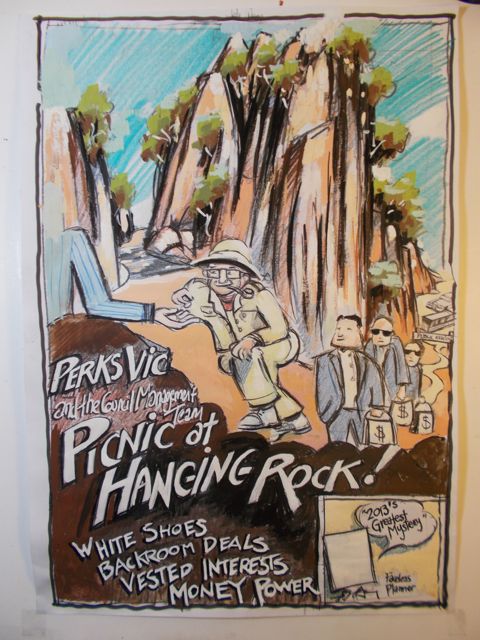A comment on yesterday’s piece by Quentin Cockburn on Fascism from our Musical Dispatchee. He writes
Quentin, Very interesting that bit about fascism. (I think I used fascism in one of the earlier dispatches.)
When you research fascism you find all sorts of clear as mud explanations and contradictory definitions.
I myself have no problem with using the word as an emotive word.
When I say Tony Abbott is a Fascist I know exactly what I mean and I reckon a whole lot of people agree with me.
Apart from the Title alliteration, my favourite line is:
…..a sort of folk dancing version of Pol Pot……
Incidentally the “Fabulous Fascism” reminds me of John Lennon ….. “Great Britain, Great Britain what sort of name is that for a country? Why not Amazing America or Fabulous France”
Not sure but he may have had a few more such as ‘Beautiful Belgium” etc.
By the way…. Couldn’t agree more with your observations about the DLP having at last had an electoral victory.
Am old enough to clearly remember Mannix, Santamaria and their cohorts. They were carrying on with their sneaky campaign when we (the Baarda’s) arrived in Australia. It didn’t take us long to tweak to what was happening. Southern Dutch families with large numbers of children (yeah I know you come from a large family, so did my mother. These families were large for a completely different reason) had preference over small northern Dutch families, and not just because of the numbers (Populate or Perish). Well earned was Immigration Minister Arthur Calwell’s anointment as a Knight of Columbus.
 (From my father) Dr. Goebbels was to make a speech at the 46,000 capacity Rheinland Stadium in Oberhausen.[1] Fifteen-year-old dad went along with a group of youths from his neighbourhood.
(From my father) Dr. Goebbels was to make a speech at the 46,000 capacity Rheinland Stadium in Oberhausen.[1] Fifteen-year-old dad went along with a group of youths from his neighbourhood.
All took whistles that they intended to use to disrupt the speech. Joseph Goebbels started: “Deutsche Männer und Frauen…”German men and women…” …absolute silence, no one dared to pull out their whistle…Goebbels then launched into his usual propaganda rave.
On the way home the reaction from dad’s mates was “Der hat recht!”…He’s right you know!
The Nazis had set up soup kitchens (‘Brown Houses’) where you could get a feed and a brown uniform. According to dad, the hungry, unemployed and poor population was “heel makkelijk overtuigd” Very easily won over by Nazi propaganda.
Dad’s attendance at the rally reinforced his belief that ‘the game was up’.
[1] Oct’08- In reply to an email: Frank Dittmeyer, MA Geschichtswerkstatt Oberhausen has sent me the following information: “In 1933 a mass meeting took place in the stadium…the principal speaker, Goebbels…Es gibt sogar ein Foto von diesem Tag, das ich beifüge” (there is a photo from that day, which I attach).
So again, minor details confused in time: the rally took place in the summer of 1933 (not 1932) and the stadium was the Niederrheinstadion (lower-Rhine stadium) the Rhine Stadium per sé is in Dusseldorf. Unless it happens there were more than one rally.

